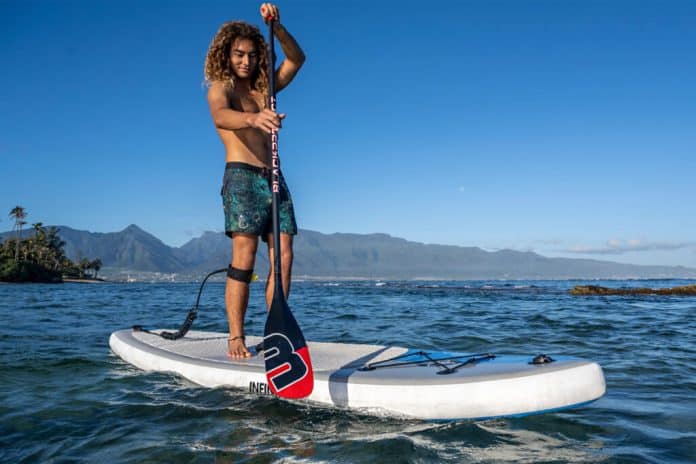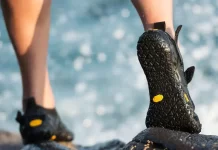Have you ever wondered whether your SUP paddle is the right size for you? As avid paddleboarders, we understand the importance of finding the perfect paddle length for a comfortable and efficient ride.
In this article, we will explore the telltale signs of a paddle that is either too long or too short, helping you make the proper adjustment to enhance your paddleboarding experience. Whether you’re a beginner or an experienced paddler, finding the right paddle length can make all the difference in your performance on the water. Let’s dive in and discover how to determine if your SUP paddle is too long or too short.
Factors to Consider
When it comes to choosing the right paddle for stand-up paddleboarding (SUP), there are several factors that we need to consider. These factors are crucial in determining the overall performance, efficiency, and comfort of our paddling experience. Let’s explore each factor in detail and understand how it can impact our paddleboarding sessions.
Paddle Shaft Length
The length of the paddle shaft is an essential consideration when selecting a SUP paddle. It determines how far the blade is positioned in the water and affects our stroke efficiency and reach. Paddle shaft lengths can vary, but the general rule of thumb is that the paddle should be approximately 8-10 inches taller than our height.
Paddle Blade Surface Area
The surface area of the paddle blade also plays a significant role in our paddleboarding experience. A larger blade surface area provides more power and is suitable for surfing and racing, where a higher stroke rate is required. On the other hand, a smaller blade surface area is ideal for leisurely paddling and cruising as it reduces fatigue and allows for a more relaxed pace.
Paddle Shaft Material
The material of the paddle shaft can impact its weight, durability, and overall performance. Common paddle shaft materials include aluminum, fiberglass, carbon fiber, and wood. Aluminum shafts are cost-effective and durable, while carbon fiber shafts are lightweight and offer excellent performance. Fiberglass and wood shafts provide a balance between durability and weight. Choosing the suitable material depends on our budget, preferences, and intended use.
Paddle Weight
The weight of the paddle is another crucial factor to consider. A lighter paddle can reduce fatigue and strain on our arms and shoulders, making it easier to paddle for extended periods. However, it’s essential to strike a balance, as an overly light paddle may lack the necessary power and control. Experimenting with different weights and finding a paddle that feels comfortable and suits our strength is essential.
Paddle Blade Material
The material of the paddle blade can affect its performance, durability, and buoyancy. Common blade materials include plastic, fiberglass, carbon fiber, and wood. Plastic blades are affordable and durable, while fiberglass and carbon fiber blades offer enhanced performance and responsiveness. Wood blades provide a classic and aesthetic appeal. Choosing the suitable blade material depends on our preferences, budget, and desired paddling experience.
Paddle Blade Shape
The shape of the paddle blade also plays a role in determining its performance and efficiency. There are generally two main blade shapes: dihedral and flat. Dihedral blades have a ridge down the middle that helps to redirect water while reducing flutter and providing stability. Flat blades, on the other hand, have a larger surface area and are more suitable for power and speed. Deciding on the blade shape depends on our specific paddling style and preferences.
Choosing the Right Paddle Length
Now that we understand the various factors involved in choosing a SUP paddle, let’s focus on selecting the correct paddle length. Determining the appropriate paddle length is crucial for optimizing our performance, efficiency, and overall enjoyment of the water. Here are the key considerations to consider when selecting the paddle length that suits us best.
Stand-Up Paddleboarding Style
The first factor to consider is our stand-up paddleboarding style. Different styles, such as touring, racing, surfing, or casual cruising, have unique requirements when it comes to paddle length. For example, in surfing, a shorter paddle is preferred to maneuver through waves, while in racing, a longer paddle allows for more vigorous strokes and increased speed. Understanding our preferred style of paddleboarding will help guide us in choosing the right length.
Height and Arm Length
Our height and arm length should also be considered when selecting a SUP paddle length. Taller individuals generally require longer paddles to compensate for their reach, while shorter individuals may need shorter paddles for a more comfortable stroke. A simple rule of thumb is to add 8-10 inches to our height to determine the recommended paddle length. However, personal preferences and arm length can vary, so it’s essential to consider these factors.
Preferences and Intended Use
Our personal preferences and intended use play a significant role in determining the ideal paddle length. Some paddlers may prefer a longer paddle for more powerful strokes and increased speed, while others may opt for a shorter paddle for enhanced maneuverability and control. It’s essential to assess our paddling style, strength, and goals to make an informed decision about paddle length.
Effects of Paddle Length
The length of our SUP paddle directly impacts our performance, efficiency, stability, and water control. Let’s explore the effects of paddle length and how it influences our paddleboarding experience.
Performance
The paddle length significantly impacts our overall performance on the water. A paddle that is too long can result in an ineffective stroke, making it difficult to generate power and acceleration. Conversely, a paddle that is too short may limit our reach and compromise our ability to fully engage the entire blade surface, resulting in less effective strokes. Finding the right paddle length ensures optimal performance and helps us maximize our potential on the water.
Efficiency
Efficiency is key in any paddling endeavor. An appropriately sized paddle allows us to paddle with less effort and strain on our muscles, ensuring a more efficient stroke. When the paddle is too long, it can lead to unnecessary fatigue and overreach, making each stroke less efficient. Conversely, a paddle that is too short may limit our stroke range and force us to work harder to maintain a consistent pace. By choosing the right paddle length, we can paddle more efficiently and enjoy longer and more comfortable sessions.
Stability
Paddle length can also affect our stability on the board. A paddle that is too long may disrupt our balance, as the extended reach can be challenging to manage. On the other hand, a paddle that is too short may cause us to lean excessively and compromise our stability. Finding the right paddle length that provides sufficient reach without compromising our balance is crucial for maintaining stability on the water.
Control
Control is vital in various paddling situations, and the paddle length contributes to our ability to maneuver and control our board effectively. An appropriately sized paddle allows for precise strokes and quick direction changes. When the paddle is too long, it can make navigating tight turns or maneuvering in crowded areas more challenging. Conversely, a paddle that is too short may limit our control, making it challenging to maintain a straight line or execute specific strokes. The right paddle length ensures optimal control and maneuverability, allowing us to navigate water conditions confidently.
Signs of a Long Paddle
Using a paddle that is too long can negatively impact our paddleboarding experience. Here are some signs that indicate our paddle may be too long:
Ineffective Stroke
If we struggle to generate power or our strokes feel weak and inefficient, it might be a sign that our paddle is too long. With an extended paddle length, we may have difficulty achieving an optimal paddle angle, resulting in less effective propulsion through the water. If we consistently experience this issue, it may be time to try a shorter paddle length.
Difficulty Maneuvering
Maneuvering our board can become more challenging when using a paddle that is too long. It can make executing sharp turns or navigating tight spaces cumbersome. If we frequently struggle to maneuver our board easily, it could indicate that our paddle length inhibits our ability to control our board effectively.
Fatigue and Overreach
Using a paddle that is too long can lead to unnecessary fatigue and overreach. With each stroke, we may stretch too far, causing strain on our muscles and joints. This overreach can result in fatigue, impacting our endurance and enjoyment of the water. Suppose we frequently experience fatigue or discomfort, especially in our shoulders and arms. In that case, it may be time to consider a shorter paddle length that promotes a more natural and comfortable paddling motion.
Signs of a Short Paddle
While a paddle that is too long can present challenges, using a paddle that is too short also has its drawbacks. Here are some signs that indicate our paddle may be too short:
Limited Reach and Power
A paddle that is too short limits our reach and compromises our power in each stroke. We may be straining to fully engage the entire blade surface, resulting in a less powerful stroke. Additionally, a shorter paddle may force us to adopt an uncomfortable and inefficient paddling position, impacting our overall performance and enjoyment on the water.
Missed Strokes
When our paddle is too short, we may miss our strokes or only partially submerge the blade. This can lead to an uneven rhythm and decreased efficiency in our paddling technique. Missing strokes not only affect our speed and overall performance but can also disrupt our balance and stability on the board.
Inefficient Paddling Technique
Using a paddle that is too short may force us to adopt an inefficient paddling technique. For instance, we may need to bend our upper body excessively, leading to potential strain and discomfort. It can also result in a more vertical paddling angle, reducing the power and efficiency of each stroke. If we consistently struggle with an awkward or inefficient paddling technique, it might be a sign that our paddle length is too short.
Methods to Determine Paddle Length
To ensure we select the proper paddle length, there are several methods we can use to guide our decision-making process. Here are some standard methods to determine the ideal paddle length:
Manufacturer’s Guidelines
Many paddle manufacturers provide guidelines or sizing charts to help us select the appropriate paddle length. These guidelines often consider our height, intended use, and paddling style. While these recommendations can provide a solid starting point, it’s important to remember that personal preferences, body proportions, and arm lengths can vary. Therefore, it’s crucial to consider these factors alongside the manufacturers’ guidelines.
On-Water Testing
One of the most reliable methods to determine the correct paddle length is on-water testing. By renting or borrowing paddles of different lengths, we can paddle with each length and assess their feelings regarding reach, power, comfort, and control. Experimenting with different paddle lengths in real time allows us to make precise adjustments and discover the length that best suits our individual needs and preferences.
Body Measurements
Utilizing our body measurements is another practical way to gauge the correct paddle length. As a general rule of thumb, adding 8-10 inches to our height provides a starting point for determining paddle length. However, it’s essential to consider other factors such as arm length, paddling style, and preferences. Measuring our arm span (distance between fingertips with arms outstretched) and comparing it to our height can provide additional insights into the appropriate paddle length.
Adjusting Paddle Length
Sometimes, even after meticulous consideration, we may find that the initially selected paddle length doesn’t feel right. It’s important to remember that the perfect paddle length can be a personal preference that varies depending on our body mechanics and paddling style. Here are some methods for adjusting and personalizing our paddle length:
Experimentation and Personalization
Through experimentation, we can fine-tune our paddle length to suit our individual needs. Gradually adjusting the paddle length by small increments, such as half an inch at a time, can make a noticeable difference. This allows us to find the sweet spot where reach, power, and comfort align. By evaluating each adjustment and noting the impact on our stroke efficiency and overall paddling experience, we can refine our paddle length until we achieve optimal performance.
Using Adjustable Paddles
Adjustable paddles provide an excellent option for those who prefer flexibility in paddle length. These paddles generally feature a telescopic design or an adjustable collar that allows us to modify the length to suit different conditions or preferences. Using an adjustable paddle enables us to quickly fine-tune the length of the water, making it a convenient option for individuals who engage in various paddling styles or who share their equipment with others.
Choosing the Right Blade Size
Apart from paddle length, the size of the paddle blade also plays a role in optimizing our paddleboarding experience. The blade size affects the power, speed, and maneuverability during each stroke. Let’s explore some key considerations when choosing the right blade size for our SUP paddle.
Blade Size and Paddle Length Ratio
Finding an appropriate blade size for our paddle length is crucial for balanced performance. As a general guideline, a longer blade provides more power but requires more effort, while a shorter blade reduces fatigue but sacrifices some power. Strike a balance that complements our skill level, intended use, and physical capabilities. Experimenting with different blade sizes and paddle lengths can help us find the right combination that optimizes our paddling performance.
Leisure and Cruising
For leisurely paddling and cruising, a smaller blade size is often preferred. This allows for a more relaxed pace and reduces strain on our muscles, enabling us to enjoy longer sessions on the water without fatigue. Smaller blades are generally more forgiving and enable us to maintain a consistent paddling rhythm, making them an ideal choice for casual paddlers who prioritize comfort and relaxation.
Surfing and Racing
For activities like surfing and racing, a larger blade size is typically favored. Larger blades generate more power and speed, allowing quick acceleration and maneuverability. However, it’s essential to ensure that the larger blade size is proportionate to our strength and fitness level. Using a blade size that exceeds our capabilities can lead to fatigue and affect our paddling technique. By finding the right balance between power and control, we can optimize our performance in activities that require high-speed turns and bursts of acceleration.
Impact of Blade Size
Understanding how blade size affects our paddleboarding performance will help us make an informed decision. Here are some key impacts of blade size to consider:
Power and Speed
A larger blade size generates more power, allowing us to accelerate quickly and maintain a faster speed. When paddling against solid currents or windy conditions, a larger blade can offer the additional power needed to overcome resistance. However, it’s crucial to ensure that we have the strength and endurance to handle the increased power, as a blade that is too large can lead to premature fatigue.
Stamina and Fatigue
The blade size directly affects the amount of effort required to paddle. A larger blade size demands more energy and can lead to faster fatigue, especially for less experienced or physically less fit paddlers. Conversely, a smaller blade size requires less effort and allows for longer and more enjoyable paddling sessions. Selecting the appropriate blade size ensures we can paddle comfortably without excessive strain or exhaustion.
Control and Maneuverability
The blade size also impacts our control and maneuverability on the water. A larger blade may require more effort to control, especially during quick turns or precise strokes. While it offers power, it may hinder some finesse and precision required for specific paddling techniques. On the other hand, a smaller blade size provides greater control and allows for more precise movements, making it easier to navigate tight spots or execute specific strokes.
Other Considerations
In addition to paddle length and blade size, there are several other considerations to keep in mind when selecting the right SUP paddle:
Grip Design and Material
The grip design and material can significantly impact our comfort and control while paddling. Paddle grips can vary in shape, texture, and ergonomics. It’s essential to choose a grip that feels comfortable in our hands and provides a secure hold, even when wet. Grips made of rubber or foam can enhance grip and reduce the chances of slippage during paddling sessions.
Cost and Budget
Cost is always a factor when purchasing equipment, and SUP paddles are no exception. The price range for paddles can vary depending on the materials, design, and brand. It’s essential to establish a budget and explore paddle options within that range. Balancing cost with quality is crucial, as investing in a higher-quality paddle often results in better performance, durability, and overall satisfaction in the long run.
Equipment Maintenance Tips
Caring for our SUP paddle properly ensures its longevity and optimal performance. It’s essential to rinse the paddle with fresh water after each use to remove any saltwater or debris that may cause damage.
Storing the paddle in a dry and protected area, away from extreme temperatures and direct sunlight, helps maintain its structural integrity. Regularly inspecting the paddle for signs of wear and tear and promptly addressing any issues ensures it performs optimally.
Choosing the right SUP paddle is a personal and essential decision for every stand-up paddleboarder. By considering factors such as paddle length, blade size, and other crucial elements, we can ensure an enjoyable, efficient, and comfortable paddleboarding experience.
Whether we’re leisurely cruising, racing, or surfing, finding the perfect paddle that suits our individual needs will enable us to embrace the beauty and excitement of stand-up paddleboarding fully. So, let’s paddle on and explore the wonders that await us on the water!





































